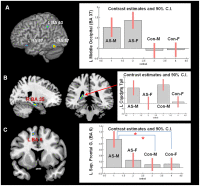Sex differences and autism: brain function during verbal fluency and mental rotation
- PMID: 22701630
- PMCID: PMC3373504
- DOI: 10.1371/journal.pone.0038355
Sex differences and autism: brain function during verbal fluency and mental rotation
Abstract
Autism spectrum conditions (ASC) affect more males than females. This suggests that the neurobiology of autism: 1) may overlap with mechanisms underlying typical sex-differentiation or 2) alternately reflect sex-specificity in how autism is expressed in males and females. Here we used functional magnetic resonance imaging (fMRI) to test these alternate hypotheses. Fifteen men and fourteen women with Asperger syndrome (AS), and sixteen typically developing men and sixteen typically developing women underwent fMRI during performance of mental rotation and verbal fluency tasks. All groups performed the tasks equally well. On the verbal fluency task, despite equivalent task-performance, both males and females with AS showed enhanced activation of left occipitoparietal and inferior prefrontal activity compared to controls. During mental rotation, there was a significant diagnosis-by-sex interaction across occipital, temporal, parietal, middle frontal regions, with greater activation in AS males and typical females compared to AS females and typical males. These findings suggest a complex relationship between autism and sex that is differentially expressed in verbal and visuospatial domains.
Conflict of interest statement
Figures



References
-
- Volkmar FR, Klin A. Pervasive Developmental Disorders. In: Kaplan and Sadock’s Comprehensive Textbook of Psychiatry CD-ROM 7th edition. Publisher: Lippincott Williams and Wilkins, Philadelphia, PA. 2000.
-
- Cahill L. Why sex matters for neuroscience. Nature reviews. Neuroscience, Jun. 2006;7(6):84. - PubMed
-
- Baron-Cohen S. Autism: the empathizing-systemizing (E-S) theory. Annals of the New York Academy of Sciences. Mar. 2009;1156:80. - PubMed
Publication types
MeSH terms
Grants and funding
LinkOut - more resources
Full Text Sources
Research Materials
Miscellaneous

